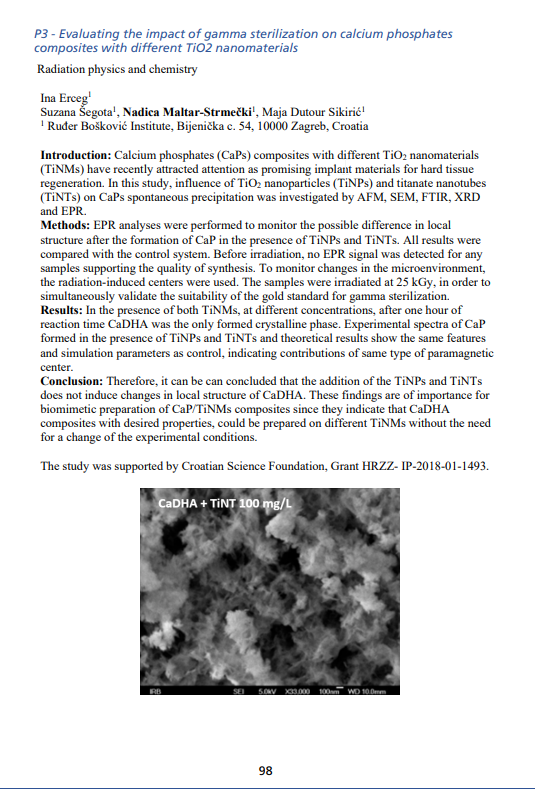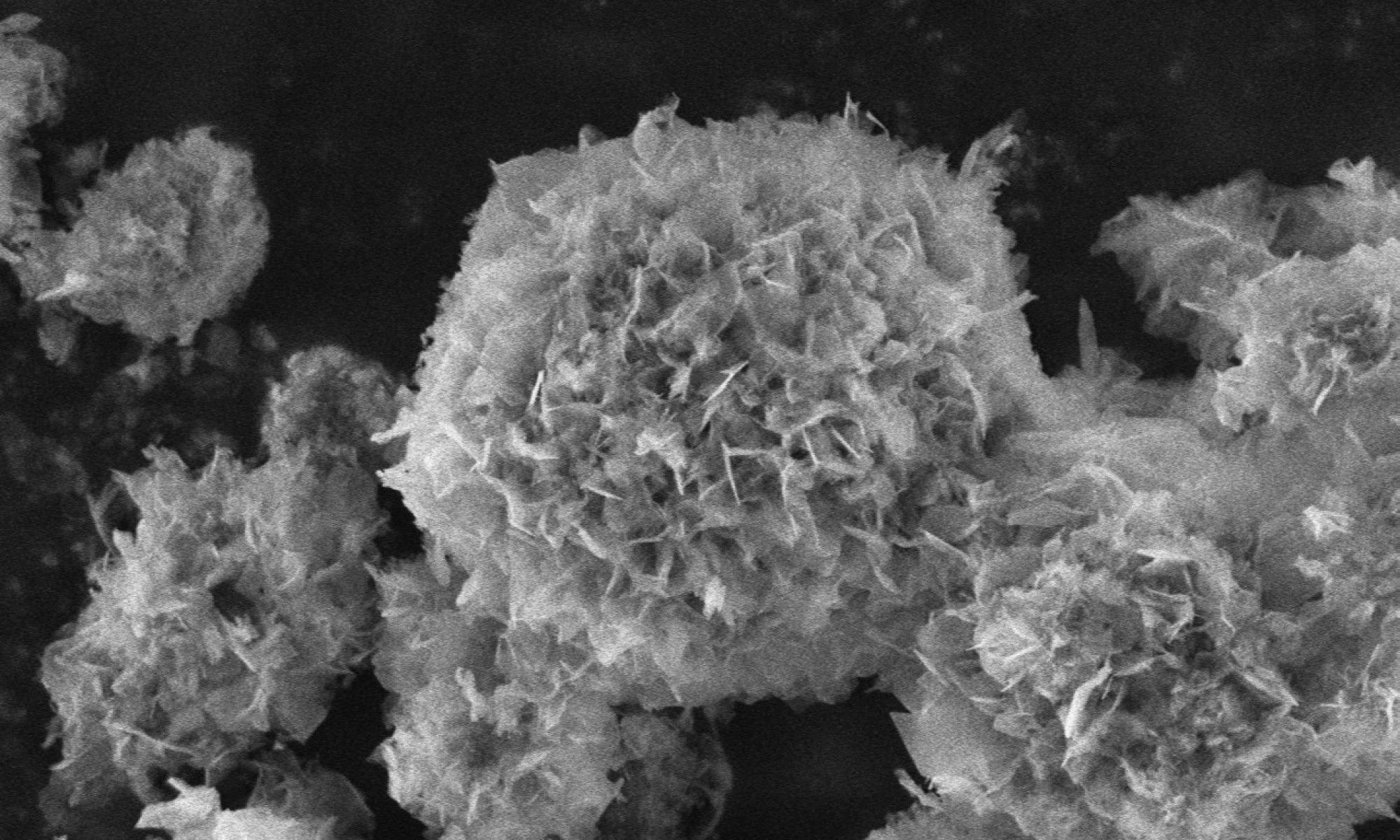The congress was held in Poreč, from 18th to 20th of May 2022. Ina held a lecture titled Simultaneous influence of titanate nanomaterials and chitosan on calcium phosphate. The abstract of this lecture is here:
Paper titled Precipitation of Calcium Phosphates and Calcium Carbonates in the Presence of Differently Charged Liposomes was published in Jurnal Minerals
The paper was published on 6th February 2022 in open acces.
You can read the whole paper on this link:
Minerals | Free Full-Text | Precipitation of Calcium Phosphates and Calcium Carbonates in the Presence of Differently Charged Liposomes (mdpi.com)
The abstract of the paper is here:
Abstract
Liposomes (lipid vesicles) are often considered to be a versatile tool for the synthesis of advanced materials, as they allow various control mechanisms to tune the materials’ properties. Among diverse materials, the synthesis of calcium phosphates (CaPs) and calcium carbonates (CaCO3) using liposomes has attracted particular attention in the development of novel (bio)materials and biomineralization research. However, the preparation of materials using liposomes has not yet been fully exploited. Most of the liposomes used have been anionic and/or zwitterionic, while data on the influence of cationic liposomes are limited. Therefore, the aim of this study was to investigate and compare the influence of differently charged liposomes on CaPs and CaCO3 formation. Zwitterionic 1,2-dimyristoyl-sn-glycero-3-phosphocholine (DMPC), negatively charged 1,2-dimyristoyl-sn-glycero-3-phospho-L-serine (DMPS), and positively charged 1,2-dioleoyl-sn-glycero-3-ethylphosphocholine (EPC) lipids were used to prepare the respective liposomes. The presence of liposomes during the spontaneous precipitation of CaPs and CaCO3 affected both the precipitation and transformation kinetics, as well as the morphology of the precipitates formed. The most prominent effect was noted for both materials in the presence of DMPS liposomes, as (nano) shell structures were formed in both cases. The obtained results indicate possible strategies to fine-tune the precipitation process of CaPs and CaCO3, which may be of interest for the production of novel materials.Keywords: calcium phosphates; calcium carbonates; liposomes; amorphous phases; nanoshells
Ina Erceg presented on the 35th Conference of the European Colloid & Interface Society (ECIS)
The conference was held in Athens, Greece, from 5 to 10 September 2021. Ina presented work titled Comparison of chitosan and albumin influence on calcium phosphate formation on TiO2 nanomaterials.
Ina Erceg has attended Joint meeting of Dreilandertagung & multinational congress on microscopy
The meeting was held from 22 till 26. August 2021. online. The title of the presentation is Calcium phosphate formation on TiO2 nanomaterials – finding a suitable biomimetic route of nanocomposites preparation. The abstract of her presentation is here:
A study published in Nanomaterials Journal
Our study titled “Precipitation at Room Temperature as a Fast and Versatile Method for Calcium Phosphate/TiO2 Nanocomposites Synthesis” was published in Nanomaterials Journal by Ina Erceg ,Atiđa Selmani ,Andreja Gajović ,Borna Radatović ,Suzana Šegota,Marija Ćurlin, Vida Strasser, Jasminka Kontrec, Damir Kralj, Nadica Maltar-Strmečki,Rinea Barbir, Barbara Pem, Ivana Vinković Vrček and Maja Dutour Sikirić
Abstract
The constantly growing need for advanced bone regeneration materials has motivated the development of calcium phosphates (CaPs) composites with a different metal or metal-oxide nanomaterials and their economical and environmentally friendly production. Here, two procedures for the synthesis of CaPs composites with TiO2 nanoplates (TiNPl) and nanowires (TiNWs) were tested, with the immersion of TiO2 nanomaterials (TiNMs) in corrected simulated body fluid (c-SBF) and precipitation of CaP in the presence of TiNMs. The materials obtained were analyzed by powder X-ray diffraction, spectroscopic and microscopic techniques, Brunauer–Emmett–Teller surface area analysis, thermogravimetric analysis, dynamic and electrophoretic light scattering, and their hemocompatibility and ability to induce reactive oxygen species were evaluated. After 28 days of immersion in c-SBF, no significant CaP coating was formed on TiNMs. However, the composites with calcium-deficient apatite (CaDHA) were obtained after one hour in the spontaneous precipitation system. In the absence of TiNMs, CaDHA was also formed, indicating that control of the CaP phase formed can be accomplished by fine-tuning conditions in the precipitation system. Although the morphology and size of crystalline domains of CaDHA obtained on the different nanomaterials differed, no significant difference was detected in their local structure. Composites showed low reactive oxygen species (ROS) production and did not induce hemolysis. The results obtained indicate that precipitation is a suitable and fast method for the preparation of CaPs/TiNMs nanocomposites which shows great potential for biomedical applications. View Full-TextKeywords: calcium phosphates; TiO2 nanoplates; TiO2 nanowires; precipitation; simulated body fluid; reactive oxygen species; hemocompatibility
More info is available here: https://www.mdpi.com/2079-4991/11/6/1523
A chapter published in Encyclopedia of Materials: Technical Ceramics and Glasses
Maja Dutour Sikirić and Vida Strasser have published a chapter titled “Bone Regeneration With Ceramics Scaffold” in Encyclopedia of Materials: Technical Ceramics and Glasses
More info: https://www.elsevier.com/books/encyclopedia-of-materials/pomeroy/978-0-12-818542-1
Ina Erceg attended 3rd Workshop on Characterization and Analysis of Nanomaterials
Ina Erceg, a PhD student has presented her results at 3rd Workshop on Characterization and Analysis of nanomaterials held on February 3-5, 2021 by University of Aveiro, Portugal.

Paper published in the journal Radiation Physics and Chemistry
Timor Grego, Lara Jurković, Daniel Mark Lyons, Damir Kralj, and Nadica Maltar-Strmečki have published an article titled “The influence of the saline and artificial saliva on gamma induced radical concentration in dental bone graft materials based on calcium sulfate studied by EPR spectroscopy” in the journal Radiation Physics and Chemistry, Volume 177, 2020, 109138,
ISSN 0969-806X,
https://doi.org/10.1016/j.radphyschem.2020.109138.
Abstract: Calcium sulfate (CS) is a reasonable alternative to autogenous dental bone graft and is used as a bone filler or for the treatment of bone defects. Medical grade CS must be sterilized, usually by gamma-irradiation. In this study the structures of CS polymorphs, calcium sulfate dihydrate and calcium sulfate hemihydrate, have been investigated with electron paramagnetic resonance (EPR) spectroscopy, X-ray diffraction, thermogravimetric analyses and infrared spectroscopy. The influences of saline and artificial saliva on gamma-induced radical concentrations have been monitored.
Keywords: Electron paramagnetic resonance; Calcium sulfate; Bone grafts; Sterilization; Saliva; Saline; Crystallization; Polymorphs
Paper published in Journal of the Mechanical Behavior of Biomedical Materials
Jelena Macan, Maja Dutour Sikirić, Marco Deluca, Raul Bermejo, Carmen Baudin, Milivoj Plodinec, Krešimir Salamon, Miran Čeh and Andreja Gajović have published a paper titled ” Mechanical properties of zirconia ceramics biomimetically coated with calcium deficient hydroxyapatite” in
Journal of the Mechanical Behavior of Biomedical Materials, Volume 111, 2020, 104006, ISSN 1751-6161, https://doi.org/10.1016/j.jmbbm.2020.104006.
Abstract: Mechanical properties and stability of porous tetragonal yttria-stabilised zirconia (Y-TZ) ceramics, biomimetically coated with calcium deficient hydroxyapatite (CaDHA) to obtain a bioactive material, were investigated. The 5.7 mol% yttria-stabilised tetragonal zirconia was obtained by sol-gel process and sintered at different temperatures to obtain a homogeneous and porous structure whose strength would match that of human bone. Sufficient strength was achieved by sintering at 1400 °C. The CaDHA coating was obtained at room temperature by a simplified preparation method consisting of immersion of the Y-TZ ceramics into a calcifying solution, after a short surface pretreatment in HCl. Although HAP or β-TCP are more frequently used, CaDHA was chosen due to its structural similarity to the bone mineral and ability to support bone ingrowth to a greater extent than biphasic calcium phosphates. To verify the applicability CaDHA coatings, we tested their adherence to Y-TZ ceramics for the first time to the best of our knowledge. Vickers hardness (3.8 ± 0.2 GPa) reflected the hardness of underlying ceramic. The tensile strength (269 ± 52 MPa) and Weibull modulus (5) of the obtained biomaterials matched or exceeded those of bone. There was no statistical difference in the tensile strength between the coated (269 ± 52 MPa) and the uncoated (239 ± 46 MPa) ceramics. The Y-TZ-CaDHA coating system presented adequate structural integrity under scratch test with critical load for coating cracking of 18 ± 2 N. These results indicate the potential of the prepared bioceramic to be used as bone implants.
Keywords: Yttria stabilised zirconia; Sol-gel process; Calcium phosphates; Metastable calcifying solution; Mechanical properties
Nadica Maltar Strmečki attended 45th Annual Meeting of the European Radiation Research Society (ERRS2020)
The 45th Annual Meeting of the European Radiation Research Society (ERRS2020), was held as a virtual conference broadcasted from Lund on 13th – 17th September 2020.

